Topics List
Jan. 25, 2017 Updated
HISAKI, to Prove Solar Wind’s Influence on the Inner Magnetosphere of Jupiter
|
HISAKI, JAXA’S Spectroscopic Planet Observatory for Recognition of Interaction of Atmosphere presents the monitoring data that show solar wind influences Jupiter's inner magnetosphere, the most powerful in the solar system. The finding contradicts the previous hypothesis that solar wind influence on the planet’s inner part is negligible, since its magnetosphere is huge and is rotationally dominated. Research on the response of Jupiter's inner magnetosphere to solar wind requires long, continuous monitoring, just the type of observation HISAKI makes. Its one month long spectroscopic observation on Jupiter updates the theory. |
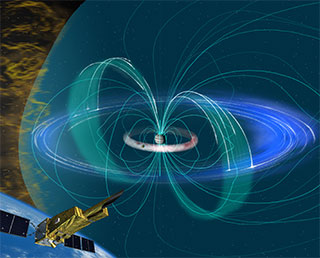
|
|---|
Mar. 24, 2016 Updated
“Hisaki” (SPRINT-A) captures the powerful Jovian auroras caused by the solar winds
|
“Hisaki” (SPRINT-A), in cooperation with NASA’s Chandler X-ray telescope and XMM Newton, observed Jovian auroras for 2 weeks. |
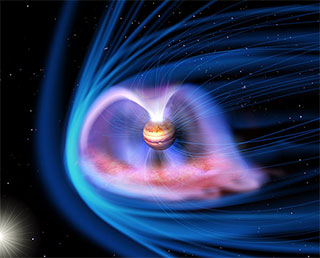
|
|---|
Mar. 25, 2015 Updated
HISAKI’s first observation of Jupiter’s magnetosphere
|
A research team led by Researcher Tomoki Kimura (researcher of the Japan Aerospace Exploration Agency as well as a research fellowship for young scientist of the Japan Society for the Promotion of Science) captured a sudden brightening (auroral expansion) through long-term continuous observations of Jupiter by the Spectroscopic Planet Observatory for Recognition of Atmosphere "HISAKI," and clarified for the first time in the world that this phenomenon was caused by the rapid rotation of Jupiter. |
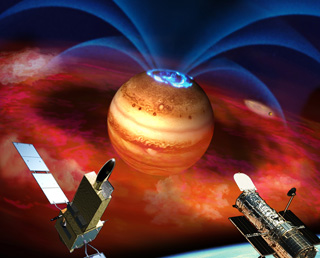
|
|---|
Sep. 26, 2014 Updated
HISAKI’s first observation of Jupiter’s magnetosphere
|
The Spectroscopic Planet Observatory for Recognition of Interaction of
Atmosphere "HISAKI" launched by the Epsilon Launch Vehicle on Sept. 14,
2013, observed Jupiter’s magnetosphere using its onboard extreme
ultraviolet spectroscope (EUV), and captured evidence that hot
electrons flow toward Jupiter. This is important proof to support
conventional theory. |
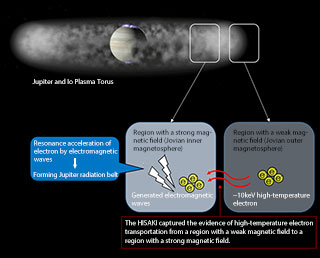
|
|---|
Sep. 15, 2013 Updated
HISAKI (SPRINT-A) Orbit Calculation Result and Critical Operation Period Completion
|
JAXA confirmed that the Spectroscopic Planet Observatory for Recognition of Interaction of Atmosphere "HISAKI" (SPRINT-A) was injected into the planned orbit after its orbit calculation. |
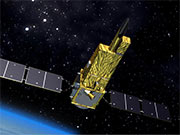
|
|---|
Sep. 14, 2013 Updated
SPRINT-A Solar Array Paddles Deployment and Nickname Decided
JAXA confirmed that the Spectroscopic Planet Observatory for Recognition of Interaction of Atmosphere (SPRINT-A) has deployed its solar array paddles (SAPs) normally at 15:49 p.m. today through data received at the Uchinoura Ground Station. The SPRINT-A was launched by the Epsilon-1 from the Uchinoura Space Center at 14:00 p.m. on September 14, 2013.
The satellite is currently in good health.
The SPRINT-A's nickname was also decided. It is "HISAKI" The name was chosen for the following reasons.
(1) "Hisaki" is the name of a cape in the Uchinoura area. (The cape at the tip of the Tsushiro Peninsula.)
(2) Our observation targets are beyond ("saki" in Japanese) the sun ("Hi" in Japanese).
Sep. 14, 2013 Updated
Launch Result of Epsilon-1 with SPRINT-A aboard
|
JAXA launched the first Epsilon Launch Vehicle (Epsilon-1) with the Spectroscopic Planet Observatory for Recognition of Interaction of Atmosphere (SPRINT-A) onboard at 14:00 on September 14 (Sat.), 2013 (Japan Standard Time, JST) from the Uchinoura Space Center. |
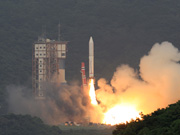 |
|---|
Sep. 12, 2013 Updated
Epsilon-1/SPRINT-A new launch date decided!
|
JAXA would like to announce that we have set the launch date and time of the first Epsilon Launch Vehicle (Epsilon-1) with the Spectroscopic Planet Observatory for Recognition of Interaction of Atmosphere (SPRINT-A) onboard as follows. |
 |
|---|
Sep. 9, 2013 Updated
New Launch Day Information for Epsilon-1 with SPRINT-A Onboard
|
The Japan Aerospace Exploration Agency (JAXA) decided to postpone the launch of the first Epsilon Launch Vehicle (Epsilon-1) with the Spectroscopic Planet Observatory for Recognition of Interaction of Atmosphere (SPRINT-A) onboard on August 27 from the Uchinoura Space Center. As a result of our cause investigation of the postponement and re-examination of the Epsilon-1, the new launch date will be September 14, 2013 (Japan Standard Time) or later. |
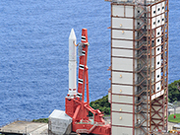 |
|---|
Aug. 27, 2013 Updated
Launch Cancellation of Epsilon-1 with SPRINT-A Onboard
|
The Japan Aerospace Exploration Agency (JAXA) cancelled today's launch of the first Epsilon Launch Vehicle (Epsilon-1) with the Spectroscopic Planet Observatory for Recognition of Interaction of Atmosphere (SPRINT-A) onboard from the Uchinoura Space Center, because an automatic stop alarm was issued as an attitude abnormality was detected approximately 19 seconds prior to the liftoff time during the automatic countdown sequence. The launch had been originally scheduled for 1:45:00 p.m. today (Japan Standard Time). |
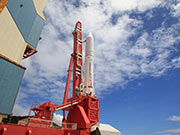 |
|---|
Aug. 8, 2013 Updated
Launch Postponement and Launch Time Change for Epsilon Launch Vehicle with SPRINT-A onboard
|
The Japan Aerospace Exploration Agency (JAXA) decided to postpone the launch of the first Epsilon Launch Vehicle (Epsilon-1) with the Spectroscopic Planet Observatory for Recognition of Interaction of Atmosphere (SPRINT-A) onboard to August 27, 2013,?from the Uchinoura Space Center as JAXA has taken extra time to rectify the incompatibility* found in the ground support equipment during the communication function test between the Epsilon-1 and the equipment in the course of launch campaign at the launch site. The launch was originally scheduled for August 22, 2013 from the center. |
 |
|---|
May 21, 2013 Updated
Spectroscopic Planet Observatory for Recognition of Interaction of Atmosphere (SPRINT-A) launch by Epsilon-1
|
The first Epsilon Launch Vehicle (Epsilon-1) with the Spectroscopic Planet Observatory for Recognition of Interaction of Atmosphere (SPRINT-A) onboard is determined to be launched on August 22 (Thursday, Japan Standard Time). The launch time is between 1:30 thru 2:30 p.m. (JST), and the launch site is the Uchinoura Space Center. |
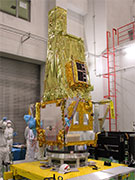 |
|---|